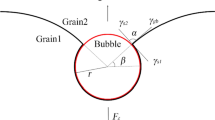Abstract
Similar to the capillary phenomenon of liquid, granular particles can move up to a certain height along a vertically vibrating tube. The certain height, which is called the equilibrium height, is related to some parameters, e.g., the inner diameter of the tube, the amplitude, and the vibration frequency. In this paper, a theoretical model is proposed to explain the physical origin of the capillary phenomenon and the effects of the inner diameter of the tube, the amplitude, and the vibration frequency on the equilibrium height. In this model, the volumes of the inflowing and outflowing particles in a vibration period are calculated, which can significantly broaden our understanding in the flow of particles in the bottom of the tube. In order to prove the assumption of this physical model that the particles in the bottom of the tube move in the form of sine, several experiments are conducted. The granular climbing heights at different granular positions and different time stages are measured. The results show that granules move in the form of sine, which almost coincides with the motion of the tube. Moreover, motivated by the sampling on the asteroid regolith based on this mechanism, the sampling efficiencies for various vibration amplitudes and frequencies are discussed based on the new proposed model. It is found that there is an optimum frequency at which sampling is the most effective.
Similar content being viewed by others
References
JAEGER, H. M., NAGEL, S. R., and BEHRINGER, R. P. Granular solid, liquids, and gases. Reviews of Modern Physics, 68, 1259–1273 (1996)
YANG, F., WANG, L., YIN, S., LI, Y., LIU, C., and TONG, L. Experimental study on the entrainment characteristics of ultrafine powder in a fluidized bed with vibrator and agitator. Industrial & Engineering Chemistry Research, 52, 1359–1364 (2013)
KANAI, K., UGAWA, A., and SANO, O. Experiment on vibration-induced pattern formation of a vertically thin granular layer. Journal of the Physical Society of Japan, 74, 1457–1463 (2005)
EHRICHS, E., JAEGER, H., KNIGHT, J., NAGEL, S., KARCZMAR, G., and KUPERMAN, V. Granular convection observed by magnetic resonance imaging. Science, 267, 1632–1634 (1995)
PAUL, B. U., FRANCISCO, M., and HARRY, L. S. Localized excitations in a vertically vibrated granular layer. nature, 382, 793–796 (1996)
HSIAU, S. S., WU, M. H., and CHEN, C. H. Arching phenomena in a vibrated granular bed. Powder Technology, 99, 185–193 (1998)
KNIGHT, J., JAEGER, H., and NAGEL, S. Vibration-induced size separation in granular media: the convection connection. Physical Review Letters, 70, 3728–3731 (1993)
SCHRÖTER, M., ULRICH, S., KREFT, J., SWIFT, J., and SWINNEY, H. Mechanisms in the size segregation of a binary granular mixture. Physical Review E: Statistical Nonlinear and Soft Matter Physics, 74, 011307 (2006)
THOMAS, N. and D’ORTONA, U. Evidence of reverse and intermediate size segregation in dry granular flows down a rough incline. Physical Review E: Statistical Nonlinear and Soft Matter Physics, 97, 022903 (2018)
PAK, H. K. and BEHRINGER, R. P. Surface waves in vertically vibrated granular materials. Physical Review Letters, 71, 1832–1835 (1993)
UGAWA, A. and SANO, O. Dispersion relation of standing waves on a vertically oscillated thin granular layer. Journal of the Physical Society of Japan, 71, 2815–2819 (2002)
LIU, C., WU, P., and WANG, L. Particle climbing along a vibrating tube: a vibrating tube that acts as a pump for lifting granular materials from a silo. Soft Matter, 9, 4762–4766 (2013)
LIU, Y. and ZHAO, J. Experimental study and analysis on the rising motion of grains in a vertically-vibrated pipe. Chinese Physics B, 24, 034502 (2005)
ZHANG, F. W., WANG, L., LIU, C. P., and WU, P. Climbing motion of grains in vibrating tubes with different geometries. Advanced Powder Technology, 28, 356–362 (2017)
LIU, C. P., ZHANG, F. W., WU, P., and WANG, L. Effect of hoisting tube shape on particle climbing. Powder Technology, 259, 137–143 (2014)
ZHANG, F. W., CRONIN, K., LIN, Y. H., LIU, C. P., and WANG, L. Effects of vibration parameters and pipe insertion depth on the motion of particles induced by vertical vibration. Powder Technology, 333, 421–428 (2018)
WIDOM, B. Capillarity and wetting phenomena: drops, bubbles, pearls, waves. Physics Today, 57, 66–67 (2004)
AKIYAMA, T. and SHIMOMURA, T. Investigation of wall shear stress in vibrating particle beds. Powder Technology, 66, 243–247 (1991)
AKIYAMA, T. and SHIMOMURA, T. Measurements of wall shear stress in particle beds when vibrations are imposed vertically along the direction of shear. Advanced Powder Technology, 4, 129–142 (1993)
FAN, F., PARTELI, E., and PÖSCHEL, T. Origin of granular capillarity revealed by particlebased simulations. Physical Review Letters, 118, 218001 (2017)
XU, Y., MUSSER, J., LI, T., PADDING, J. T., and ROGERS, W. A. Particles climbing along a vertically vibrating tube: numerical simulation using the discrete element method (DEM). Powder Technology, 320, 304–312 (2017)
VANEL, L., CLAUDIN, P., BOUCHAUD, J. P., CATES, M. E., CLÉMENT, E., and WITTMER, J. P. Stresses in silos: comparison between theoretical models and new experiments. Physical Review Letters, 84, 1439–1442 (2000)
MÜLLER, T. G., ĎRECH, J., ISHIGURO, M., MUELLER, M., KRÜHLER, T., YANG, H., KIM, M. J., O’ROURKE, L., USUI, F., KISS, C., ALTIERI, B., CARRY, B., CHOI, Y. J., DELBO, M., EMERY, J. P., GREINER, J., HASEGAWA, S., HORA, J. L., KNUST, F., KURODA, D., OSIP, D., RAU, A., RIVKIN, A., SCHADY, P., THOMAS-OSIP, J., TRILLING, D., URAKAWA, S., VILENIUS, E., WEISSMAN, P., and ZEIDLER, P. Hayabusa-2 mission target asteroid 162173 ryugu (1999 JU3): searching for the object’s spin-axis orientation. Astronomy & Astrophysics, 599, A103 (2017)
Author information
Authors and Affiliations
Corresponding author
Additional information
Project supported by the National Natural Science Foundation of China for Distinguished Young Scholars (No. 11525208)
Rights and permissions
About this article
Cite this article
Zhang, N., Cheng, B. & Baoyin, H. A new physical model on the capillary phenomenon of granular particles. Appl. Math. Mech.-Engl. Ed. 40, 127–138 (2019). https://doi.org/10.1007/s10483-019-2406-6
Received:
Revised:
Published:
Issue Date:
DOI: https://doi.org/10.1007/s10483-019-2406-6




